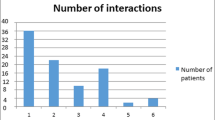Summary
The awareness of the digoxin-quinidine interaction in the mid-70s led to increased interest in drug interactions. Much has been published on the subject in the form of interaction reports, handbooks, lists, cards, discs etc. However, only a few interactions in the literature have clinical significance and can be remembered by thinking in terms of groups, pharmacokinetics and probabilities.
It is important to realise that drugs in a given class will have similar properties. Thus, phenylbutazone, like any other nonsteroidal anti-inflammatory drug (NSAID), is likely to potentiate the effects of warfarin. A knowledge of drug pharmacokinetics is also essential; a highly protein-bound drug may displace another when they are administered together. Remembering those drugs which induce liver enzyme formation will prevent their co-administration with drugs which have a critical dose-range. If a general practitioner can remember the few drugs in clinical practice with a narrow therapeutic index, he can consult a handbook before anything else is prescribed.
Some interactions will rarely be encountered in daily general practice, i.e. those associated with tuberculosis treatment or anaesthetic agents. Other interactions, e.g. the interaction between antihypertensive treatment and over-the-counter medication containing phenylpropanolamine, are more common.
While most drug interactions can be avoided by thinking in terms of groups, pharmacokinetics and probabilities, some learning by rote is required, e.g. the potential for heart failure with concomitant β-blocker and nifedipine therapy.
In general, a schematic approach using thinking in terms of groups, pharmacokinetics and probabilities will prevent most clinically significant drug interactions; the rest can be avoided by consulting appropriate handbooks and specialists.
Similar content being viewed by others
References
D’Arcy PF. Drug interactions. In D’Arcy PF, Griffin JP (Eds) Iatrogenic diseases, 3rd ed., p. 921, Oxford University Press, Oxford, New York & Tokyo, 1986
Dukes MNG, Swartz B. Responsibility for drug-induced injury. Elsevier Science Publishers, Amsterdam, New York & Oxford, 1988
Editorial. Drug interactions. Lancet 1: 904–905, 1975
Frey W. Über Vorhofflimmern beim Menschen und seine Beseitigung durch Chinidin. Klinische Wochenschrift 55: 450–452, 1918
Loeliger EA, Broekmans AW. Drugs affecting blood clotting, fibrinolysis and hemostasis. In Dukes MNG (Ed.) Meyler’s side effects of drugs, 11th ed., pp. 733–775, Elsevier Science Publishers, Amsterdam, New York & Oxford, 1988
Urquhart J, Heilmann K. Risk watch: the odds of life. Facts on File Publications, New York & Bicester, 1984
Withering W. An account of the foxglove, and some of its medical uses. Robinson, Birmingham, 1785
Author information
Authors and Affiliations
Rights and permissions
About this article
Cite this article
Dukes, M.N.G. Health Implications of Drug Interactions. Drug-Safety 5 (Suppl 1), 84–87 (1990). https://doi.org/10.2165/00002018-199000051-00013
Published:
Issue Date:
DOI: https://doi.org/10.2165/00002018-199000051-00013




